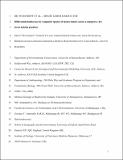Differential habitat use by sympatric species of mouse lemurs across a mangrove–dry forest habitat gradient
Abstract
Understanding the mechanisms by which similar species coexist in sympatry is a major driver of ecological research. Niche partitioning and ecological plasticity can facilitate spatial and habitat use overlap between generalist and specialist species. Mouse lemurs (Microcebus spp.) are a highly speciose group of small primates that are endemic to the forests of Madagascar. In northwestern Madagascar, the relatively widespread M. murinus occurs sympatrically with the microendemic M. ravelobensis. We investigated spatial distributions and densities of these two species across a mangrove–dry forest habitat gradient in Mariarano commune. We used capture-mark-recapture techniques and nocturnal line transect surveys along six transects during June and July 2017. Spatial capture-recapture and distance sampling models were used to estimate lemur densities across habitat types. The congeners displayed differential patterns of spatial distribution and densities. Microcebus murinus was found in similar densities across all habitat types, while M. ravelobensis was found at much higher densities in dry forests compared with mangroves. This suggests that the generalist M. murinus uses a wider array of habitats more evenly than the specialist M. ravelobensis. Our study provides empirical evidence of how cryptic lemur species differ in their habitat use and distribution across an environmental gradient and provides new insights into their ecology in an understudied habitat. Lemurs are one of the most threatened groups of mammals in the world, and understanding how these species are distributed across different forest types is crucial for planning and implementing conservation measures to protect lemur habitat.
Citation
Wuesthoff , E F , Fuller , T K , Sutherland , C , Kamilar , J M , Ramanankirahina , R , Rakotondravony , R , Rouse , S & Radespiel , U 2021 , ' Differential habitat use by sympatric species of mouse lemurs across a mangrove–dry forest habitat gradient ' , Journal of Mammalogy , vol. 102 , no. 5 , pp. 1266–1278 . https://doi.org/10.1093/jmammal/gyab082
Publication
Journal of Mammalogy
Status
Peer reviewed
ISSN
0022-2372Type
Journal article
Description
This study benefitted from funding by the BiodivERsA initiative of the European Community (No. 2015-138) and more specifically by the German Bundesministerium für Bildung und Forschung (Project No. 01LC1617A) to UR. Additional funding and equipment was provided by Operation Wallacea and the Institute of Zoology, Hannover.Collections
Items in the St Andrews Research Repository are protected by copyright, with all rights reserved, unless otherwise indicated.

